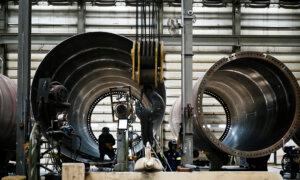President-elect Donald Trump vows to lower inflation by tackling energy costs and fixing any lingering supply chain bottlenecks.
President-elect Donald Trump told Time magazine in an interview published on Dec. 12 that his campaign pledge to bring down prices for U.S. households hinges on addressing both high energy costs and fixing “broken” supply chains.
Trump acknowledged it will be “very hard” to bring down prices from elevated levels and expressed confidence that this can be achieved under his administration by adopting a comprehensive policy mix. In addition to Trump’s “drill, baby, drill” agenda of unleashing domestic energy production on the back of deregulation and faster permitting, the president-elect identified fixing persistent supply chain bottlenecks as a key part of the inflation reduction equation.
“I think that energy is going to bring them down. I think a better supply chain is going to bring them down,” Trump said. “The supply chain is still broken.”
Supply chain disruptions were widely recognized as a major factor driving inflation in the two years following the COVID-19 pandemic. Their continued effect on current inflation remains less clear.
EJ Antoni, an economist at the Heritage Foundation, told The Epoch Times that the supply chain normalization of recent months suggests that demand-side factors are the predominant factor in the current chapter of the inflation story.
“We didn’t have inflation simply because supply chains were snarled; we had inflation because the government spent, borrowed, and printed trillions upon trillions of dollars it didn’t have,” Antoni said.
Trump did not detail specific solutions for the lingering supply chain issues. He emphasized the importance of addressing them as part of a comprehensive approach.
His broader strategy to combat inflation includes reducing reliance on offshore supply chains by incentivizing domestic production. For instance, he has proposed lowering the corporate tax rate from 21 percent to 15 percent for companies manufacturing in the United States.
In addition to addressing energy and supply chains, Trump has pledged to extend tax cuts, roll back regulations, and renegotiate trade policies to bolster American industry. “We’re going to see what happens,” Trump said in the Time interview, adding that “this country is bloated with rules, regulations, and with, frankly, people that are unnecessary.”
Trump highlighted plans to streamline the federal workforce by shifting workers from government jobs to the private sector. “We are going to need a lot of people in a lot of other jobs. We’re looking to get people into private sector jobs where they can do better and be more productive,” he said, suggesting he believes this approach will boost economic efficiency and could ease private sector wage pressures.
Kevin Stocklin contributed to this report.
Original News Source Link – Epoch Times
Running For Office? Conservative Campaign Consulting – Election Day Strategies!


